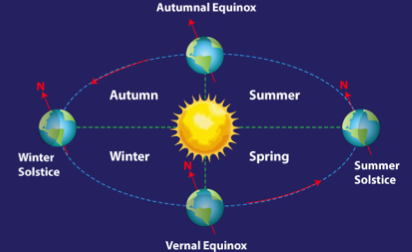Sign up for FlowVella
Sign up with FacebookAlready have an account? Sign in now
By registering you are agreeing to our
Terms of Service
Loading Flow

The seasons and how they work
The Earth's axis is tilted at an angle of 23.5 degrees. This means that the Earth always has one side facing the Sun as it goes around. So, sometimes the Sun is in the direction that the Earth is pointing, but not at other times. The different amounts of sunlight around the Earth during the year create the seasons.
The tilt of the Earth's axis is the most important reason why seasons happen.
We have hot summers and cold winters because of the tilt of the Earth's axis.
The tilt of the Earth means the Earth will lean towards the Sun (Summer) or lean away from the Sun (Winter) 6 months later. In between these, Spring and Autumn will occur.

The shortest day of the year is called the Winter solstice, and the Summer solstice is the longest day of the year. They happen when the sun is the furthest away from the Equator.